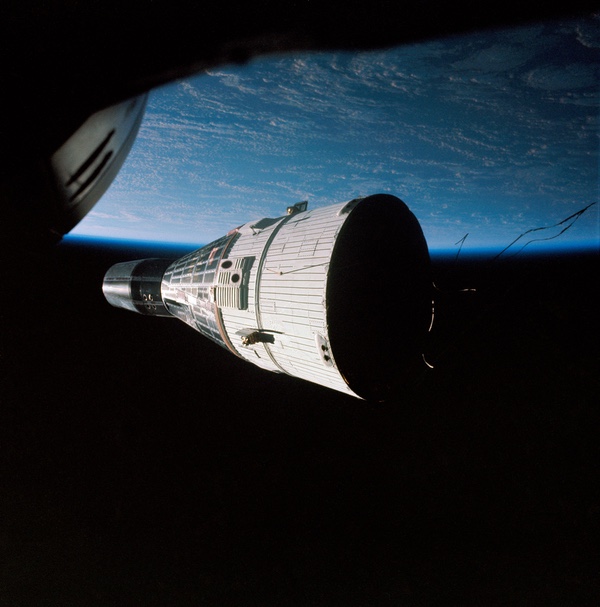A darker shade of blue: The unknown Air Force manned space programby Dwayne A. Day
|
| If the senior political leadership lifted the restriction on the Air Force man-in-space program, Schriever would be ready. |
The Air Force canceled MISS when manned spaceflight was turned over to NASA at the orders of President Eisenhower, but the Air Force still contracted Lockheed to build its pressurized MISS spacecraft. The Air Force hired the Itek Corporation to build a high-powered camera system for the spacecraft, which it designated the Samos E-5. The large pressurized container was not ideal for a camera system, and it puzzled Jack Herther, the camera designer. Herther was unaware of the spacecraft’s origins and wondered why his company was being forced to design a compromised camera system to fit inside a spacecraft, rather than having Lockheed build the spacecraft around the best possible camera system.[1]
What Herther and his fellow Itek engineers did not realize was that reconnaissance was not the driving factor in the development of this new spacecraft. General Bernard Schriever, the legendary head of the Ballistic Missiles Division, had approved the Samos E-5 in order to have a pressurized Air Force spacecraft that was large enough to carry a human, (albeit a small human). If the senior political leadership lifted the restriction on the Air Force man-in-space program, Schriever would be ready.
Samos E-5 flew five times starting in spring 1961 and it failed every single time. But the Air Force had developed a pressurized spacecraft big enough to hold a man. By the second half of 1960, the Air Force had also contracted Lockheed to build a chimpanzee “life cell” for the Samos E-5 spacecraft and was evaluating chimpanzee flights of up to 14 days, including travel through the Van Allen radiation belts. This was part of the Bioastronautical Orbital Space System, or BOSS program. An Air Force officer explained that after they had proved that the life cell worked, it would be relatively easy to develop a manned version of the spacecraft.[2]
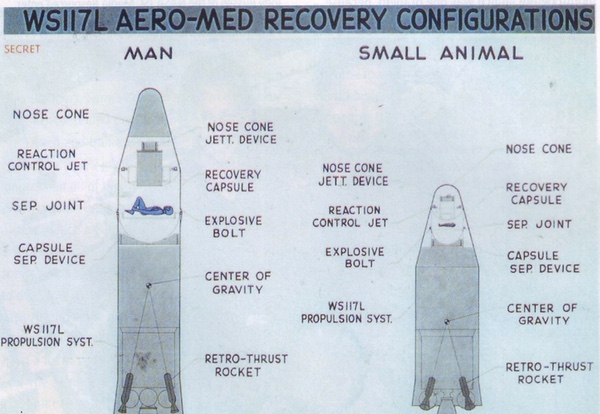 In 1959, the Air Force began development of a pressurized spacecraft that was ostensibly designed to carry a reconnaissance camera, but was actually intended to be easily converted into a manned spacecraft. Details on this spacecraft remain sketchy. (credit: NRO) |
While Schriever and his officers were evaluating BOSS, they were also involved in another primate program. As part of the cover story for the CORONA reconnaissance satellite program, the Air Force had undertaken a project to launch up to three rhesus monkeys aboard recoverable Discoverer spacecraft. The initial launch had originally been planned for 1959, but the plans slipped to 1960 and then to 1962 before the program was completely canceled. Another proposed Air Force primate program was called “Space Canary” and would have involved flying a rhesus monkey along with a human astronaut in a spacecraft. This plan was based upon the theory that the monkey would show ill effects of spaceflight and serve as a warning to the human—instead of the other way around.
BOSS was also never approved, although the Air Force apparently tried to obtain funding for it at least twice, in 1961 and then again in 1962. But its existence demonstrates that the US Air Force had an active manned spaceflight program during the time period when the military was officially banned from having its own manned spaceflight projects because they would duplicate the civilian Mercury program. Although histories of the Air Force space program have discussed the service’s development of the Dyna-Soar spaceplane during this time, Dyna-Soar was an advanced program that was not expected to fly until the mid-1960s. What the Samos E-5 and BOSS documentation indicates is that the Air Force also had a less ambitious shadow manned space program, one that was apparently not officially sanctioned by the White House. The existence of this program also helps explain the Air Force’s next steps in acquiring its own manned space program, Blue Gemini.
Mercury Mark II
NASA’s Space Task Group began working on the Mercury spacecraft in the latter half of 1958. By January 1959, someone had proposed expanding the capsule to include a second astronaut, but this proposal was rejected as impractical at that time. Two years later, in March 1961, shortly before Al Shepard’s short suborbital hop in a Mercury capsule, NASA engineer Max Faget asked Mercury contractor McDonnell to consider designing a two-man Mercury spacecraft. By the summer of 1961 the “Mercury Mark II” entered early development.
| By February 1962 the Air Force indicated during congressional budget hearings that the service was evaluating the Gemini spacecraft for its own purposes. |
In late July, several NASA leaders from the Space Task Group and at least one astronaut traveled to St. Louis to see McDonnell’s proposals. The company displayed quarter-scale models of four spacecraft proposals: an Eighteen Orbit Mk. I, a Minimum Change Mk. II, a Reconfigured Mk. II, and a Two Man Mk. II. The company had also built a full-size wood and plastic mockup of the two-man spacecraft. After this NASA review in summer 1961, and before the United States had even placed an American in orbit, NASA ordered the two-man Mercury Mark II into full development. The larger two-man version of the spacecraft would be capable of operating for longer periods in orbit and would allow an astronaut to exit the vehicle in flight.
This bigger spacecraft would also need a larger launch vehicle, a converted Titan II ballistic missile. The Titan II was an Air Force missile and naturally required close coordination between NASA and the Air Force. In early December 1961, NASA Associate Administrator Robert Seamans and the Deputy Director for Research and Engineering at the Pentagon, John Rubel, sent a letter to Secretary of Defense Robert McNamara outlining their understanding of the division of effort between NASA and the DoD in the development of space rendezvous and other spacecraft capabilities. They stated that the resources of the Air Force would be “utilized in a contractor relationship by the NASA to the maximum degree practicable, both in order to facilitate the attainment of project objectives and to permit DoD organizations to acquire useful design, development and operational experience.” The Air Force would serve as the contractor for Titan II and Atlas-Agena. “DoD responsibilities should also include assistance in the provision and selection of astronauts and the provision of launch, range and recovery support, as required by NASA,” the agreement stated.[3]
At the time, the Air Force’s Dyna-Soar was not scheduled to make its first flight until the mid-1960s. That was a long time for the Air Force to wait to fly an astronaut. A further problem was that the Air Force needed to figure out what missions a man could perform in space, and it made little sense to wait years for Dyna-Soar to offer that opportunity when a nearer-term vehicle could supply the answers. General Schriever and others realized that Gemini could enable them to gain experience that could then be used with Dyna-Soar. By February 1962 the Air Force indicated during congressional budget hearings that the service was evaluating the Gemini spacecraft for its own purposes.
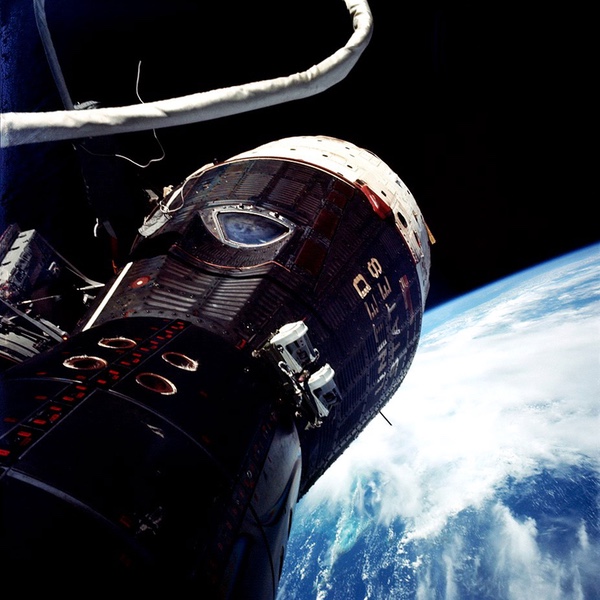 In October 1962, the Air Force proposed the "Blue Gemini" program that would consist of six Gemini flights. Initially the missions would be joint NASA-Air Force missions, but the later flights would have Air Force crews and experiments. (credit: NASA) |
MODS to Blue Gemini
The Air Force’s interest in a piloted spacecraft was part of a larger military investigation into the military missions that could be conducted in space. Starting in 1958 the Air Force began conducting limited studies of a military space station. In late 1959 in a “planning note” the Air Force’s Directorate of Development Planning supported a “manned orbital laboratory” that would serve as a space crew training facility and also as “a testbed for checking out space weapon systems.”[4]
By June 1960, the Air Research and Development Command issued a study requirement for a “Military Test Space Station,” or MTSS. The first phase of the study was completed by July 1961 and led to a follow-on study. Although the Air Force sought money to begin an active development project, in September the Office of the Secretary of Defense refused to fund it.[5]
| MODS would be used as a platform for testing electronic and other components in space based upon the assumption that astronauts could more quickly identify problems and solutions if they were there when the components failed. |
By February 1962, Air Force General James Ferguson, the Air Force’s deputy chief of staff for research and development, discussed the space station with members of Congress, telling a congressional committee that the military needed to test satellite subsystems “in a true space environment” and a space station was the best way to accomplish this. “We are convinced that a manned military test station should be undertaken as early as possible,” Ferguson said, and added that the Air Force was considering teaming with NASA and possibly using its Gemini spacecraft.[6]
Soon afterwards, Secretary of Defense McNamara sent a memorandum to the Air Force stating that “a space laboratory to conduct sustained tests of military men and equipment under actual environmental conditions, impossible to duplicate on earth, would be most desirable.” McNamara also suggested that the Air Force consider adapting Gemini and Dyna-Soar hardware for this laboratory.[7]
Air Force leaders interpreted McNamara’s memo as official approval to start work on the space station. By March 1962, Air Force officials began drafting plans for what they had now named the Military Orbital Development System, or MODS. These plans included an initial budget for the project and a timeline. By June 1962, they had defined the basic outlines of MODS. According to the initial description of the project, MODS would “provide a manned long-duration orbital base which will enable the conduct of military test and experiments under laboratory conditions in the space environment.”[8]
MODS would be used as a platform for testing electronic and other components in space based upon the assumption that astronauts could more quickly identify problems and solutions if they were there when the components failed. At the time, the military was still experiencing problems with the reliability of its satellite subsystems—things would break in orbit, satellites would die, and the operators had to piece together sketchy data to try and determine what had gone wrong. With MODS, “failures can be observed directly and design fixes made during actual testing; breadboard or mockup prototypes can be used for actual orbital demonstrations. In this sense, MODS will extend our present surface-based laboratory and testing capabilities.”[9]
But MODS’ developers had more ambitious goals beyond its initial use, describing it as “a significant step toward a long-duration manned space capability.” MODS was “not an end itself, but a means to an end.” It would enable both technology development and the attainment of operational experience.[10]
The available documentation on MODS is somewhat sketchy. MODS would have been a cylindrical space station launched atop a Titan III rocket. It would have supported a four-man crew for at least a month and been serviced by the Gemini spacecraft. But the documentation does not indicate if the space station would have been launched with a Gemini spacecraft attached, or if the initial crew would arrive later. Nor does it indicate how the second Gemini spacecraft would dock with the space station to achieve the four-man crew. The initial program plan called for a 15-month Phase I study followed by Phase II development.[11] The Air Force Chief of Staff formally approved MODS in July 1962. MODS’ initial operational capability was scheduled for March 1966.[12]
By December 1962 the Air Force had further refined MODS and opened up the possibility of using an Apollo spacecraft for servicing and the requirement for obtaining up to 1-g gravity by rotating the space station. The station would operate for at least a year in a 240-nautical-mile (444-kilometer) orbit at an inclination of 28 to 36 degrees.[13]
But soon after the Air Force’s Space System Division had started defining MODS, the Air Force officers who were working on the MODS proposal realized that waiting another three years to get Air Force officers into space would not offer them early spaceflight experience, and an incremental approach made more sense. By August 1962 they proposed Blue Gemini, a series of seven Gemini flights, some in cooperation with NASA, that would be flown before MODS became operational. Collectively, both Blue Gemini and MODS were designated as Program 287, the Air Force’s manned space program.
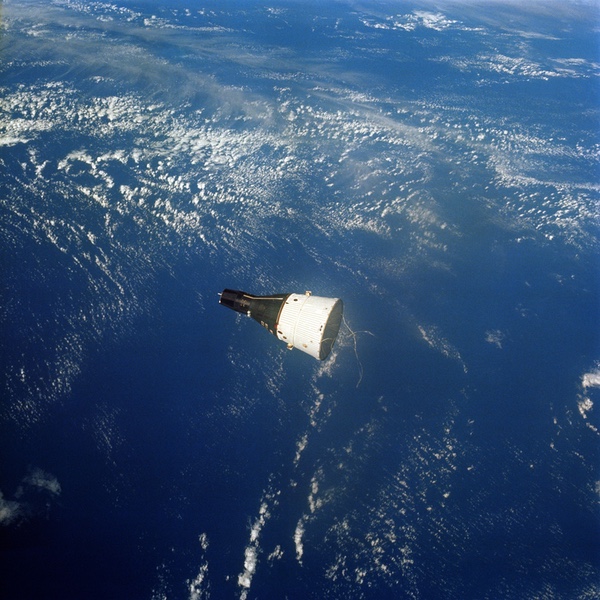 Blue Gemini represented a means for the Air Force to gain entry into human spaceflight at a time when the expensive Dyna-Soar program was many years from flight. It was not approved. (credit: NASA) |
Defining Blue Gemini
By October 1962, the Air Force formally initiated Blue Gemini and outlined it in a document known as a “Partial System Package” (or PSP) that defined what it was, what it would do, and the overall timeframe for the project.
The PSP explained that the goal of Blue Gemini was to “provide a manned, short duration, orbital vehicle which will activate the USAF military man-in-space programs, demonstrate military operations and techniques, and test and qualify subsystems and components.” By that time, MODS would not be ready until 1966. NASA planned on flying Gemini from late 1963 through 1965. Blue Gemini could therefore get the Air Force into space by 1964, with missions throughout 1965.[14]
| The Blue Gemini vehicle would essentially be an “off-the-shelf” NASA vehicle with only limited modifications for most of the missions. |
Blue Gemini was attractive to the Air Force because it consisted of “off-the-shelf” equipment: a Gemini spacecraft, a Titan II launch vehicle, an Atlas launch vehicle, and an Agena rendezvous target. The Gemini was intended to provide life support for a crew of one or two for up to 14 days, serve as an astronaut trainer, provide an early capability for space maneuvering, rendezvous and docking experience, and serve as a test bed for experiments and equipment.[15] Air Force Space Systems Division was in charge of the Blue Gemini program.
At this early phase, Gemini was still planned to make a land touchdown using a paraglider. NASA’s spacecraft would land in Webb County, Texas. But the Air Force planned on landing the X-20 Dyna-Soar at Edwards Air Force Base in California and proposed that Blue Gemini could make its landings there. This would require activation of recovery facilities at Edwards and early training of recovery personnel, thereby providing training for eventual Dyna-Soar operations.[16]
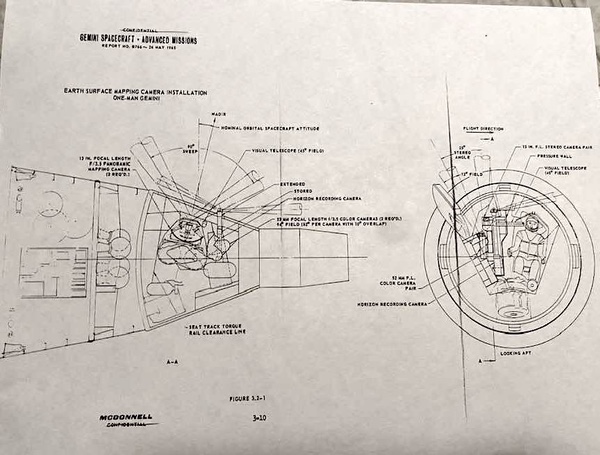 The Blue Gemini proposal was for six missions, with the last mission carrying a single astronaut and other mission equipment in the second seat. One possibility was an Earth observing radar. Another possibility was optical sensors for observing the Earth or even other spacecraft. This 1965 illustration for a NASA Gemini mission shows how optical equipment could have been fitted into the second seat. (credit: NASA) |
Blue Gemini flights
The initial phase of Blue Gemini operational missions would consist of two missions where an Air Force astronaut would fly as a Gemini co-pilot on a NASA mission accomplishing NASA objectives. The next phase would consist of two NASA Gemini missions flown by Air Force crews. The flights would meet NASA objectives necessary for the Apollo program. But if space and weight permitted, and they did not interfere with NASA objectives, they would also conduct some Air Force experiments. The plan was that these missions would occur during the second NASA rendezvous flight and the second NASA rendezvous and docking flight.[17]
The third phase of Blue Gemini would consist of a series of three follow-on Air Force flights at four-month intervals conducting Air Force experiments. The first would involve rendezvous and docking with an Agena target vehicle. The next two missions would not involve a target vehicle but would instead be devoted to testing equipment for Air Force missions. The last mission would occur in November 1965, about four months before the first scheduled launch of the Military Orbital Development System spacecraft.[18]
All of the missions would utilize the NASA Gemini launch pad, but they would have to fly to a 36-degree orbit in order to land at Edwards Air Force Base. However, if the mission objectives demanded it, the vehicle might fly to even higher inclination orbits. The first two recoveries—the NASA missions with a USAF astronaut—would land at Webb County, Texas. Subsequent launches would recover at Edwards. Alternative sites could be Holloman Air Force Base in New Mexico or Webb County.[19]
The Blue Gemini vehicle would essentially be an “off-the-shelf” NASA vehicle with only limited modifications for most of the missions. If the mission required it, approximately 200 pounds (90.7 kilograms) could be added to a 30-cubic-foot (0.85-cubic-meter) volume in the adapter section, at the expense of some maneuvering capability. By removing a man and his associated equipment, an additional 30 cubic feet could be made available inside the cockpit, allowing the installation of an additional 600 pounds (272 kilograms).[20]
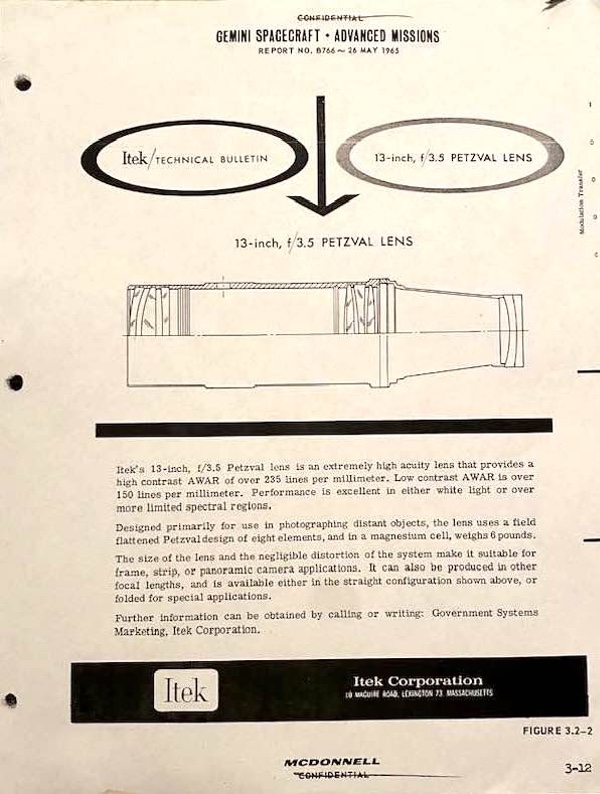 Optics company Itek proposed this lens system for an advanced Gemini mission in 1965. This is a scaled-down version of the optical system that Itek was already producing for the top secret CORONA reconnaissance camera. (credit: NASA) |
Experiments
The Partial System Package was intended to outline the kinds of missions that the spacecraft could fly, not define them in any detail. It therefore proposed a number of possible experiments for Blue Gemini. One was to test the Astronaut Maneuvering Unit or AMU, a backpack that would enable the astronaut to maneuver during a spacewalk.
The AMU was essentially the prototype for the Manned Maneuvering Unit developed by NASA during the 1980s for the Space Shuttle. It would allow an astronaut to operate untethered from his spacecraft.
| Other possible Blue Gemini missions involved what the Air Force euphemistically labeled non-cooperative targets. |
Blue Gemini could also be used to test other experiments as well. For instance, two Thor-Agena launches were already planned for demonstrating expandable structures in space. Blue Gemini could also conduct this task and the pilot could observe and photograph the deployment and short-term effects on the expandable structure over two days. The structure would then be left in orbit with telemetry equipment so that ground controllers could monitor it for long-term effects.[21]
Another experiment could be the test of a stellar inertial guidance platform. The astronaut could compare the outputs of the test system with the Gemini’s primary guidance system and ground tracking data. Two guidance systems were then under development that could be adapted to Blue Gemini, and a third system had also been proposed.[22]
The PSP also contained a much more ambitious mission proposal for a one-man spacecraft carrying a ground mapping radar. An airborne radar system had already demonstrated a resolution of 75-by-75 feet (22.9-by-22.9 meters) at a range of 80 miles (148 kilometers) from an altitude of 20,000 feet (6,100 meters). Although the spacecraft would be higher and hence farther from its target than the airborne test flight, its smoother flight compared to an aircraft could produce better resolution and verify whether space radar was a viable technology. According to the PSP document, the astronaut could adjust and evaluate the operational parameters of the radar and perform realignment and maintenance functions. “The presence of a man in the system will increase the probability of successful operation and evaluation of the equipment and speed the development of this radar sensor for satellite applications,” the document stated.
Alternatively, instead of a space radar, one of the last Blue Gemini missions could have carried other intelligence collection equipment such as infrared and optical sensors, radio frequency interception receivers, ranging radar and a secure transmission receiver. This equipment would weigh up to 600 pounds (272 kilograms). In addition, these systems would also require a recorder for storing data awaiting transmission to the ground.[23]
Other possible Blue Gemini missions involved what the Air Force euphemistically labeled non-cooperative targets. These missions were intended to take advantage of the Gemini spacecraft’s propulsion capabilities, particularly when attached to an Agena target vehicle.
With some changes in normal flight rules the Agena would make it “possible to rendezvous with targets having the 65 degree inclination used by Russian Vostok vehicles.” There were several possibilities offered by this orbit: “A flyby inspection can provide data (visual, photograph, spectrophotometric, etc.) in order to identify the target.”[24]
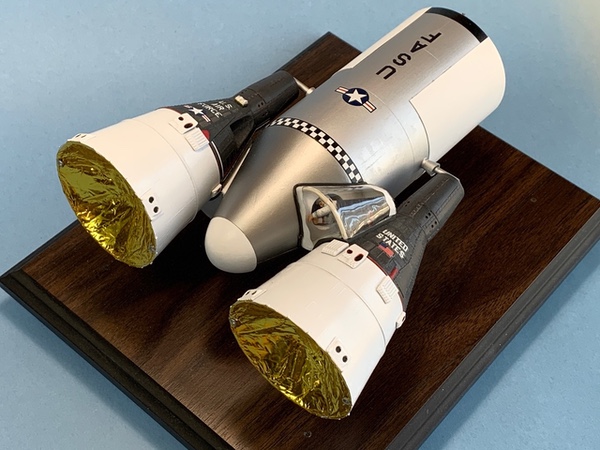 The Military Orbital Development System (MODS) was a proposal in early 1962 for a space station that would use up to two Gemini spacecraft to conduct preliminary research in space. MODS eventually evolved into the Manned Orbiting Laboratory (MOL), which had a dedicated reconnaissance mission and was canceled in summer 1969. (credit: Model and photo by Mike Mackowski) |
Political tug-of-war
Soon after the Air Force had defined its possible goals for Blue Gemini, the program became the focus of a bureaucratic struggle that led to its downfall. NASA officials had supported increased Air Force reliance upon Gemini, believing that with the Air Force buying its own spacecraft this would result in cheaper NASA Gemini operations. In November 1962, NASA officials met with representatives of the Air Force’s Space Systems Division to discuss the Gemini design.
The details of what happened remain unclear, but it appears that although Air Force Space Systems Division officials were in favor of Gemini, the senior civilian leadership of the Pentagon soon engaged in a nasty but short power play to take over Gemini. In December 1962, several NASA officials went to the Pentagon to propose greater DoD participation in Gemini. They were surprised when Secretary of Defense McNamara showed up at the meeting and suddenly proposed that the DoD completely take over the Gemini program.
As James Webb later explained it, this was a typical McNamara maneuver: “knock you down on the floor with a sledgehammer, and then, while you’re down, ask you to sign off on a particular decision.” NASA officials immediately viewed this proposal as a threat to the Gemini program. The Air Force, they argued, would not be able to maintain the Gemini program’s focus on development techniques required for the Apollo lunar landing program. They protested vigorously.
| It appears that although Air Force Space Systems Division officials were in favor of Gemini, the senior civilian leadership of the Pentagon soon engaged in a nasty but short power play to take over Gemini. |
But Air Force officials were also surprised by the proposal, and they were opposed to it as well. They believed that if they were given full responsibility for Gemini, it would threaten the Dyna-Soar spaceplane, which was always their ultimate goal. They resisted McNamara’s proposal. With NASA and the Air Force opposed, McNamara backed down, but instead proposed joint development of Gemini, rather than NASA development and Air Force purchase of production spacecraft.
All of these negotiations took place during the middle of January 1963 and by late in the month they reached a compromise: rather than a joint program, Gemini would be viewed as a program “serving common needs,” meaning that NASA and the Air Force would cooperate on the missions. But McNamara also went beyond simply agreeing to the cooperative program—he killed both MODS and Blue Gemini. They had been 2 of 13 new space programs that the Air Force had proposed in January 1963 and McNamara had rejected all 13 of them. [25]
McNamara’s actions remain puzzling. The Air Force had developed a reputation for asking for expensive space programs and expanding its agenda. The history of MODS and Blue Gemini was proof of this—after starting with a space station idea, the Air Force had added Blue Gemini and then expanded its space station plans to include artificial gravity and possibly even an Apollo spacecraft. At the time the entire Department of Defense space budget was $1.55 billion, and the Air Force had asked for a substantial increase of $420 million, including $75 million for MODS and $102 million for Blue Gemini. That was a lot of money.
However, if McNamara was concerned with the costs of the Air Force manned space program, his initial proposal would have only increased those costs. In December 1962 McNamara had supported taking over Gemini completely, which would have meant that not only would the DoD have to pay for the spacecraft, but the Gemini development costs as well. A month later he had rejected all of the Air Force’s plans for Blue Gemini, which would have been far cheaper than military control of the program.[26]
One possible explanation is that McNamara wanted what he ultimately got—limited Air Force participation in Gemini at minimal cost, and his other actions had simply been bureaucratic maneuvering. But he certainly did not need to propose taking over the program in order to attain such a limited objective. After all, he had already killed plenty of other Air Force projects with far more powerful constituencies than Blue Gemini.
By early 1963 NASA was firmly in control of Gemini, and the Air Force entered into negotiations to place some of the experiments that it had planned for Blue Gemini aboard NASA missions. These negotiations created some confusion for outside observers of the Gemini program over just how much the Air Force would be involved in Gemini. For instance, in January 1963 the Newport News Daily Press ran a United Press International newswire story with the headline “AF to Play Major Role in Gemini Space Project.” In July, Aviation Week & Space Technology ran an article with a different headline, “Air Force Will Have Small Role in Gemini.”[27] But the confusion was in actuality a fairly accurate reflection of the confusion in the Air Force, which had to engage in protracted negotiations with NASA over what experiments would be carried on a spacecraft that NASA controlled.
By early 1964, Air Force space officials were apparently unhappy over the slow pace of NASA approval of Air Force experiments aboard Gemini missions. But by May they reached agreement to include the Modular Maneuvering Unit in a future NASA Gemini mission. This was a direct descendent of the AMU that the Air Force wanted to test on its Blue Gemini missions.[28]
Around the same time McNamara canceled MODS and Blue Gemini, he also began expressing skepticism about the Dyna-Soar program, which by one estimate had already cost over half as much as the Mercury program and had only produced a mockup. Cost estimates for Dyna-Soar projected that it would ultimately cost two to two and a half times the entire Mercury program. Throughout 1963, McNamara’s opposition to Dyna-Soar increased, and by December 1963 he announced its cancellation. In its place, he also announced the creation of the Manned Orbiting Laboratory program, or MOL. MOL was in essence the revived MODS—and it would use the Gemini spacecraft.[29]
When MOL was started, the Air Force had already lost a year of development work on its military space station. But the Air Force never achieved its goal to owning its own manned spacecraft. MOL would struggle along for six years, its schedule continuously slipping and its cost rising. (See: “Blue suits and red ink,” The Space Review, November 2, 2015.) After several years of near-cancellations, it was finally killed by the Nixon Administration in summer 1969. [30]
Shedding some light on the blue
The history of the Air Force manned space program during the 1960s remains relatively unexplored. This information raises several issues and questions for researchers. First, the information on the real purposes of the Samos E-5 program and its offspring such as BOSS is only slightly better than anecdotal. Is there more information on the technical development of this spacecraft, perhaps in Lockheed archives? More importantly, are there any high-level policy documents bearing Schriever’s imprint? To what extent did Schriever have the approval of his superiors to pursue this program? And was anybody in the Eisenhower White House aware that the Air Force was trying to circumvent presidential direction on space policy? In addition, MISS itself remains a relatively unexplored subject. Who were the contractors involved in the pre-Mercury manned space program, what spacecraft did they propose, and how did their work translate into proposals for Mercury?
Second, where did the idea of utilizing the Gemini spacecraft originate in the Air Force? Did the idea come from Schriever and the senior staff in Space Systems Division, or did it originate with more junior officers who were then assisting NASA in adapting the Titan II for use with the new spacecraft?
Finally, is there more to the story about McNamara’s power play for Gemini than we already know? There are only a handful of documents on this subject, and as noted above, McNamara’s effort to take over Gemini completely, and then to eliminate Blue Gemini and MODS to save money, seem contradictory. What was McNamara’s agenda?
Acknowledgement: The author wishes to thank Archie DiFante of the Air Force Historical Research Agency for his help declassifying documents related to MODS and Blue Gemini.
References
- Dwayne A. Day, “A Sheep in Wolf’s Clothing: The Samos E-5 Recoverable Satellite, Part One,” Spaceflight, October 2002; Dwayne A. Day, “A Square Peg in a Cone-Shaped Hole: The Samos E-5 Recoverable Satellite, Part Two,” Spaceflight, February 2003; Dwayne A. Day, “From Cameras to Monkeys to Men: The Samos E-5 Recoverable Satellite, Part Three,” Spaceflight, September 2003.
- Dwayne A. Day and Colin Burgess, “Monkey in a Blue Suit,” Spaceflight, July 2006.
- Robert C. Seamans, Associate Administrator, NASA, and John H. Rubel, Deputy Director for Defense Research and Engineering, Department of Defense, to the Secretary of Defense and the NASA Administrator, “Recommendation relative to the division of effort between the NASA and the DOD in the development of space rendezvous and capabilities,” December 7, 1961. NASA History Division, Reference Collection.
- Carl Berger, “The Air Force Year in Space, Fiscal Year 1962,” USAF Historical Division Liaison Office, June 1966, Air Force Historical Research Division, K168.01-6, p. 39.
- Ibid.
- Ibid., p. 41.
- Ibid., p. 36.
- “Partial System Package Plan for Military Orbital Development System (MODS) System Number 648C,” Headquarters Space Systems Division, Air Force Systems Command, 4 June 1962, Air Force Historical Research Division, K243.8636-9, p. 1-1.
- Berger, p.36.
- Ibid.
- Ibid., p. 42.
- Major General R.M. Montgomery, Assistant Vice Chief of Staff, “Military Orbital Development System (MODS),” 12 July 1962, National Archives and Records Administration, U.S. Air Force records, Box 4, “File 1 Chief of Staff Decisions, 1962.” The date for initial operations for MODS is from the Blue Gemini Partial System Package.
- “Partial System Package Plan for Military Orbital Development System (Program 287),” Headquarters Space Systems Division, Air Force Systems Command, 10 December 1962, Air Force Historical Research Division, K243.8636-8, pp. 6-1 to 6-2.
- Headquarters, Space Systems Division, Air Force Systems Command, “Partial System Package for Program 287, Supplement I, (Blue Gemini),” 1 October 1962, Air Force Historical Research Division, K243.8636-8, p. 1-5.
- Ibid., p. 1-6.
- Ibid., p. 6-7 to 6-8.
- Ibid., p. 6-10.
- Ibid., p. 6-10.
- Ibid., p. 6-13.
- Ibid., p. 6-11 to 6-12.
- Ibid., p. 6-21.
- Ibid., p. 6-21.
- Partial System Package for Program 287, p. 6-24.
- Ibid., p. 6-25.
- Mark Erickson, Into the Unknown Together (Air Force History and Museums Program, 2005), p. 292.
- Erickson, p. 344.
- Charles W. Cordry, “AF to Play Major Role in Gemini Space Project,” Newport News Daily Press, 25 January 1963; “Air Force Will Have Small Role in Gemini,” Aviation Week & Space Technology, 22 July 1963, p. 225.
- William H. Gregory, “DoD, NASA Agree on Gemini Experiments,” Aviation Week & Space Technology, 1 June 1964, pp. 38-47. The experiments for the second, third and fourth Gemini flights were announced in April. See: “NASA Selects Gemini Experiments,” NASA News Release No. 64-78, 15 April 1964.
- MOL was initially approved by the Director of Defense Research and Engineering as a study project in August 1963. See: Harold Brown, Director of Defense Research and Engineering to Secretary of the Air Force, “Military Orbiting Space Station,” 30 August 1963.
- Michael J. Mackowski, “The Lost Missions of Gemini,” paper.
Note: we are using a new commenting system, which may require you to create a new account.
